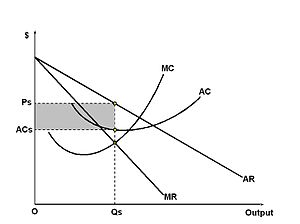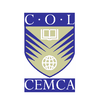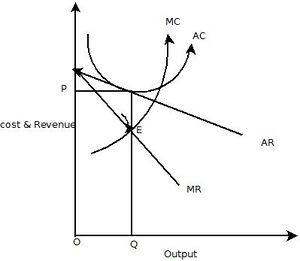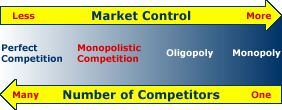Monopolistic competition
MICROECONOMICS

|
Monopolistic Competition |

|
Introduction |
I hope all of you are familiar with Perfect Competition and Monopoly market structures. But if I ask you, to identify market forms that your mother or you are visiting everyday such as vegetable market or grocery market, then you will be finding it difficult to identify that markets under perfect competition and monopoly’ s real examples, why because markets such as Perfect competition and Pure onopoly donot exist in the world.
Perfect Competition is the market structure where there are millions of buyers and sellers and product are homogeneous or same.
Pure Monopoly is the market where single seller is controlling entire supply and many buyers are existing to buy that product.
But these two are imaginary market structures which are developed for building base of economic theory. Perfect competition and monopoly are polar opposite market forms.
Mr .Chamberlin is the economist who popularised the concept of Monopolistic Competition. This market structure is the most realistic market in the world.
Which bathing soap are you using? Lux, Hamam, Sandur, Pears, Why you prefer only LUX? That answers are clear at the end of this lesson.

|
Main features |
- Large no of sellers and Large no of buyers.
- Differentiated Products.
- Freedom of entry and exit.
- Independent decision making.
- Concept of group.
- Imperfect knowledge of market
- Selling cost.
A.Large no of Selllers.
In monopolistic competition[MC], no of sellers are large, But number is not as large as perfect competition. Generally as a thump rule, it is less than 100.
But then how it is different from Perfect Competition and monopoly?
Let us take the case of market for soaps and detergents. This is the classical example of monopolistic competition. Suppose there are 51 soap producers in the market, all are selling soaps only, but each product's product is different from each other ,as a result, every producer is competing with each other, but remember products are similar,but not same. This makes this market different from perfect competition. In soap market, all are selling soaps under different names like Lux, Hamam, Santoor, Pears, Lifeboy, Dettol etc. so products are not homogeneous.
Since there are many sellers, this market is different from monopoly. But like monopoly, every seller each fix his own price in monopolistic competition. Thus in M.C. each seller is a price maker.
B. Product Differentiation.
This is the most distinct feature of M.C. In this market, all the producers are selling similar, but not the same products. The Soaps are available under different brand name, colours, size, smell. Packing etc. For eg, Lux, Hemam, Pears, Dettol, Santoor etc.
Product differentiation gives rise to an element of monopoly to each producer under M.C. Thus according to Chamberlin,M.C. is a blend of monopoly and perfect competition.
Friends, I like only Lux because of its special colour, smell or its name. Any other soap cannot substitute Lux for me.
It is clear that products in M.C, are not identical[same] as in Perfect Competition, neither are they are remote substitutes as monopoly. Real qualitative differences between the products may not be very strong in this market, but imaginary differences through colour, packing, brand name are more strong in this market.
C. Freedom of entry and exit.
This market allows freedom of entry and exit. It means any one can enter the market when they feel like and any one can go out of the market when they feel. There are no barriers of entry as in the monopoly.
Many are waiting in the market to enter with their unique[Special] product so as to attract consumers. At the time, many wants to leave the market so as to reduce the loss. Thus no sunk cost or exit cost in this market.
D.Independent decision making.
Each firm in M.C. sets its independent policy relating to price and output. Each firm feels free to set its own price and they want to become monopolists and not oligopolists. This is the main element which makes it different from Perfect competition.
E.The concept of Group.
Mr.Chamberlin has introduced the concept of Group in Monopolistic Competition. This is peculiar to M.C. Generally we use the term industry in Perfect Competition .
Group means number of producers who are producing goods which are fairly close substitutes. All are selling similar not the same products. Eg Group of producers who are producing similar soaps but not the same soaps .
F.Imperfect Knowledge about the market.
Underlying fact in M.C. is that market knowledge of buyer is limited. This is the advantage for seller. Even seller does not have detailed knowledge about market demand and supply.
G.Selling Cost:
This is most distinguishing feature of this market. This makes this market more attractive than others. Due to product differentiation, every producer has to incur some additional expenditure in the form of selling cost. According to Chamerlin, it includes:
- Expenditure on advertising and promotional activities.
- Salaries of salesman and commissions.
- Margins, dealer’s discount etc
- Window display and free distribution of samples.
As you are aware, advertisement expenditure is the most important form selling cost.
You may be thinking why Tata salt is spending lakhs of rupees on advertisement when this product is a basic necessary item and less expensive, This because this advertisement has capacity of capturing demand and increasing sales. Through advertisement, each firm tries to convince the buyers that their product is better than their competitor or rival producer.
Thus basic purpose of advertisement is to attract customers attraction and to create an permanent picture in the mind of consumer for their product.
Eg. How a small product like NIRMA[washing powder] became a stiff competitior to SURF—a product of big multinational like Unilever.
Two types of Advertisements are in market :
- Informative advertisement.
- Manipulative
- Informative advertisements are those which gives correct information about the product to customers such as price, quality, specification etc. In modern times it is really difficult to see such advts large in number.
Eg- Laptop, Personal computers , automobiles etc.
- Manipulative Advertisement:- This doesnot give proper information about the product, but tries to change mind set of consumers by way of songs, colours, roadshows etc. Most of our daily use products belongs to this group.
Eg- tooth paste, soaps, electronic goods etc.
As you are aware there are four curves which are used in any market structure for finding out equilibrium:
- Average Revenue[AR]
- Marginal Revenue[MR]
- Average Cost[AC]
- Marginal Cost[MC]
SHORT RUN EQUILIBRIUM
| TWO EQUILIBRIUM CONDITIONS |
|---|
| MC=MR |
| MC should intersect MR from below. |

- AR and MR under this market are also downward sloping like Monopoly. since each producer enjoys the element of monoploy over his products, he will try to reduce the price to sell more.
we should remeber the fact that there is not freedom of entry and exit in the short run.
A firm under M.C, `has to face various problems which are absent in Perfect Competition. In P.C, the firm can sell any amount of goods at the market price. But in M.C, individual’s sale and market share depends upon :
- 1, Price of the product
- 2.Nature of product
- 3.advertising outlay[Expend]
When a firm decides the equilibrium it has to consider all the above factors.
The demand curve under M.C. is downward sloping. We are assuming that all substitutes and its price are held constant,demand curve for the product is given.
In the diagrame, the producer is earning supernormal profits. This beacause AR> AC in the diagrame. The shaded area shows supernormal profit.
Long run the producer gets sufficient time to adjust the output and price. All factors are variable and there is freedom of entry and exit. AS a result, when there is supernormal profit, in the long run other firms get a chance to enter. This will increase the competition. As a result, supernormal profit will disappear and price will come down and firms start earning only Normal Profit which is shown in the given diagrame. The lossmaking units will not continue in the longrun, as they quit by themselves.
1.In the long run equilibrium under M.C.is established at less than Optimum size.
It means, in Perfect competition, firm reaches quilibrium at the mimimum of AC. But in M.C, eqilibrium is reached at a point LAC is falling, but not reached the minimum.
2.The price under M.C. is higher than that of P.C.
This because in M.C. each firm enjoys a degree of Monopoly. But in P.C. each firm is a price taker.
But remember though price is higher in M.C., the firms can make only normal profit like P.C.
3. There is a lot of waste under M.C.
| Combined Cost |
This includes Average Production Cost [APC] and Selling Cost[SC]. This gives clear picture of cost to the firm.
Combined Cost= APC + SC.
| Waste under Monopolistic Competition |
There are lot of waste under this market which is not existing in Perfect Competiiton.
1 Huge Expenditure on Advertisement .
2. Excess xcapacity.
3. Existence of inefficient firms.
4. Lack of standardised products.

|
Self-Assessment Questions (SAQs) {{{n}}} |
| {{{SAQ}}} | |
1,Discuss the main features of Monopolistic Competiiton.
2,Show with diagrame, how does a firm achieve equilibrium in M.C. in the short run?
3. Discuss the waste undr M.C.

|
Results |
| Number of firms | Market power | Product differentiation | Excess profits | Profit maximization condition | |
|---|---|---|---|---|---|
| Perfect Competition | Infinite | None | not existing | None | No
|
| Monopolistic competition | Many | Low | most important (long run) | ||
| Monopoly | One | High | not existing | Absolute (across industries) | Yes
|

|
Key Terms |
1.Group.
2.Selling cost
3.Product differentiation.

|
Further Readings |






